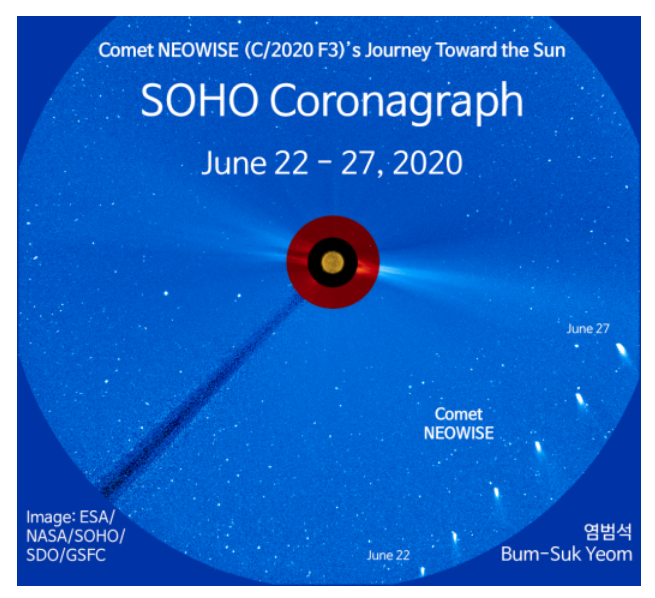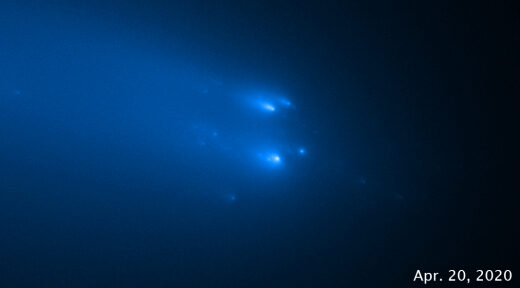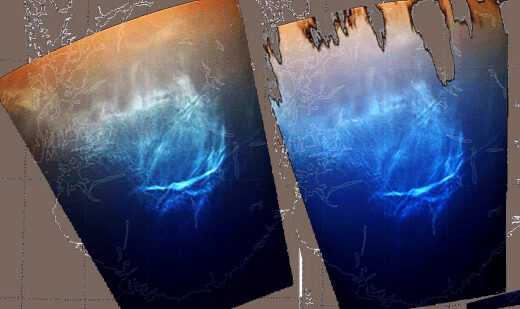"During the transit, Comet NEOWISE increased in brightness from magnitude +4 to +1.8-an almost 8-fold jump," says planetary scientist Qicheng Zhang of Caltech, who analyzed the images. "If the comet maintains this brightness, it will be visible to the naked eye when it emerges from the sun's glare in July."
Zhang is a bit concerned, however, that the rapid brightening might be too much of a good thing. "When a comet brightens this quickly (2.2 magnitudes in only ~4 days) it could be a sign that the nucleus is unstable. Comet NEOWISE might yet disintegrate," he cautions.
It wouldn't be the first time. Earlier this year two comets, ATLAS (C/2019 Y4) and SWAN (C/2020 F8), approached the sun with much fanfare, then disintegrated before they could become naked-eye objects.
Will Comet NEOWISE end the same way?
"I don't think so," says Karl Battams of the Naval Research Lab in Washington DC. "Comet NEOWISE looks healthy to me. Throughout its passage across the coronagraph, the comet showed a smooth-and-steady brightness increase, perhaps a little steeper than we might like, but nothing that makes me enormously concerned for its health, as long as it has a reasonably large nucleus."
We'll soon find out. "Later this week, around perihelion (closest approach to the sun) the comet may be observable by skilled astronomers low in the morning twilight," says Zhang. "If it maintains anything close to its brightness as it left SOHO's field of view, it will most likely be recovered from the ground by then."
Any sightings this week could be very good news, indeed. As July unfolds, the comet will swing around the sun and pop up in the evening sky-perfectly placed for casual sky watchers if anything remains to be seen. Stay tuned for updates.
3D NOCTILUCENT CLOUDS (UPDATED)
Noctilucent clouds (NLCs) have been studied for almost 200 years, yet much about them remains unknown. Seeded by meteoroids, they float near the edge of space in a layer no more than a few kilometers thick. How are the clouds arranged inside that narrow layer? Two German photographers decided to find out. During a bright display of NLCs on June 7th, Michael Theusner and Maciej Libert photographed the same clouds from two cities 120 km apart:
"The long baseline of 120 km allowed us to construct a real 3D image of that cloud," says Theusner. "First, we re-projected the images onto the ground. Then, we created an anaglyph from the undistorted images. Here it is. Using red/cyan glasses, you can see the true 3D structure of the cloud."
Many readers won't have 3D glasses. For them, Hanno Falk, an independent expert in 3D imaging, created a no-glasses version. Cross your eyes to merge the two images, shown below, and relax your stare into infinity to see the cloud's 3D structure.
The most striking feature of the 3D view is a fold in the cloud. In a wide arc across the bottom of the image, one layer of frosted meteor smoke is clearly floating atop another. The depth of the cloud is no more than 2 km.
"From the images and their geolocation, we deduced the average altitude of the cloud: 84 km," says Theusner. "Its lowest parts were at 83 km and its highest at 85 km--a very narrow layer, indeed."






Comment: See also:
- Comet ATLAS Y4 is breaking up
- Comet 67P surprises scientists with 'bright outbursts', collapsing cliffs and rolling boulders during Rosetta mission
And check out SOTT radio's: Behind the Headlines: Earth changes in an electric universe: Is climate change really man-made?